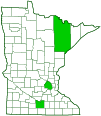Dogwood borer
(Synanthedon scitula)
Conservation • Description • Habitat • Ecology • Distribution • Taxonomy
| Hodges # | 2549 |
|
|||
Conservation Status |
|||||
| IUCN Red List | not listed |
||||
| NatureServe | NNR - Unranked |
||||
| Minnesota | not listed |
||||
Description |
Dogwood borer is a small clearwing moth. It occurs in southeast Canada and in the United States east of the Mississippi River. It is less common in Minnesota where it is at the western edge of its range. It is a major pest of pecan and flowering dogwood. Adults look convincingly like a wasp. They are 5 ⁄16″ to ½″ long and have a wingspan of 9 ⁄16″ to ¾″. They are mostly black or metallic bluish-black with yellow markings. The thorax is dark with a yellow longitudinal line on each side. The abdomen is dark with a thin yellow band on the second segment and a thicker one on the fourth segment. On the female, the band on the fourth segment is much thicker. A rounded tuft of long hairs (anal tuft) flares outward from the last abdominal segment. The anal tuft is mostly black with a few to many yellow hairs on both lateral margins and sometimes also in the middle. The forewings are 3 ⁄16″ to ⅜″ long, narrow, and rounded at the tip. They are longer and much narrower than the hindwings. They are mostly free of scales (clear) with a black border, a black bar through the discal area, a yellow patch near the tip, and dark scales along the veins. The leading (costal) margin is black with narrow yellow streaks. The hindwing is entirely clear except for dark scales along the veins. It has a dark fringe of short hairs. As with most moths, the hindwings and forewings are held in contact by bristles (a frenulum) and scales (a retinaculum). Unlike most moths, they are also held together by a rolled under inner margin of the forewing coupling with a rolled up costal margin of the hindwing. |
Size |
Total length: 5 ⁄16″ to ½″ Wingspan: 9 ⁄16″ to ¾″ |
Similar Species |
Habitat |
Deciduous woods, parks, yards |
Ecology |
Season |
Probably just one generation per year: May to September in Minnesota |
Behavior |
Adults are active during the day. |
Life Cycle |
The female lays single pale yellow eggs in the wound of a tree. She lays up to 100 or more eggs throughout the year. When an egg hatches in eight or nine days, the larva burrows under the bark. The larva will pass through seven stages (instars). In the fall it creates a cocoon-like shelter (hibernaculum) within the feeding gallery and overwinters. It resumes feeding in the spring, spins a cocoon, and emerges as an adult about 25 days later. |
Larva Hosts |
A wide variety of deciduous trees, including dogwood, black cherry, American plum, Canadian plum, pecan, hickory, oak, beech, birch, elm, mountain-ash, viburnum, willow, apple, blueberry, pine, willow, hazel, and ninebark. |
Adult Food |
|
Distribution |
||
|
Sources Biodiversity occurrence data published by: Minnesota Biodiversity Atlas (accessed through the Minnesota Biodiversity Atlas Portal, bellatlas.umn.edu, XX/XX/XXXX). |
|
| 8/28/2025 | ||
Occurrence |
||
|
||
Taxonomy |
|
Order |
|
Superfamily |
Sesioidea (carpenter, leopard, goat, and allied moths) |
Family |
Sesiidae (clearwing moths) |
Subfamily |
Sesiinae |
Tribe |
Synanthedonini |
Genus |
Synanthedon |
Subordinate Taxa |
|
|
|
Synonyms |
|
Aegeria aemula Aegeria corusca Aegeria scitula Synanthedon aemula Synanthedon corusca Synanthedon gallivorum Synanthedon hospes Trochilium gallivorum Trochilium hospes |
|
Common Names |
|
dogwood borer dogwood borer moth pecan borer pecan clearwing moth |
|
Glossary
Costal margin
The leading edge of the forewing of insects.
Frenulum
A spine (male) or multiple spines (female) at the base of the costal edge of the hindwing of many moths that couples with the retinaculum on the forewing to keep the wings in contact which each other.
Instar
The developmental stage of arthropods between each molt; in insects, the developmental stage of the larvae or nymph.
Visitor Photos |
Share your photo of this insect. |
||
This button not working for you? |
||
|
||
MinnesotaSeasons.com Photos |
|

Slideshows |
|

Visitor Videos |
Share your video of this insect. |
||
This button not working for you? |
||
|
Other Videos |
|

Visitor Sightings |
Report a sighting of this insect. |
||
This button not working for you? |
||
|
|
MinnesotaSeasons.com Sightings |
|

|
Created: 12/14/2018 Last Updated: © MinnesotaSeasons.com. All rights reserved. |
